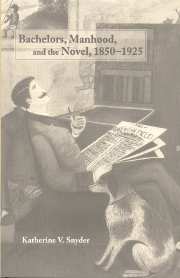Book contents
- Frontmatter
- Contents
- Acknowledgments
- Abbreviations
- Introduction
- Chapter 1 Trouble in paradise: bachelors and bourgeois domesticity
- Chapter 2 Susceptibility and the single man: the constitution of the bachelor invalid
- Chapter 3 An artist and a bachelor: Henry James, mastery, and the life of art
- Chapter 4 A way of looking on: bachelor narration in Joseph Conrad's Under Western Eyes
- Chapter 5 The necessary melancholy of bachelors: melancholy, manhood, and modernist narrative
- Afterword
- Notes
- Bibliography
- Index
Afterword
Published online by Cambridge University Press: 22 September 2009
- Frontmatter
- Contents
- Acknowledgments
- Abbreviations
- Introduction
- Chapter 1 Trouble in paradise: bachelors and bourgeois domesticity
- Chapter 2 Susceptibility and the single man: the constitution of the bachelor invalid
- Chapter 3 An artist and a bachelor: Henry James, mastery, and the life of art
- Chapter 4 A way of looking on: bachelor narration in Joseph Conrad's Under Western Eyes
- Chapter 5 The necessary melancholy of bachelors: melancholy, manhood, and modernist narrative
- Afterword
- Notes
- Bibliography
- Index
Summary
Dowell's imaginary fireside tête-à-tête brings us full circle to the imaginary hearthside communion of the mid-century bachelor in his reveries. However ironic Ford's revision of this scene of domestic intimacy may be, it nonetheless forges a link to an earlier sentimental tradition in which the exchange of feelings and words is valued as a source of moral and spiritual redemption. The high-cultural tradition of canonical male modernism has roots, albeit disavowed ones, in sentimental traditions of nineteenth-century fiction. Indeed, the redemptive ethos of this earlier tradition stands as a forerunner of the modernist valuation of the aesthetic imagination, of words themselves, as a bulwark shored against the ruins of the twentieth century. To put it another way, the cult of domesticity retains its salience in an age of transcendental homelessness. Indeed, its salience may even by intensified by its imaginary status.
The intersections between the sentimental and the modernist belie notions of an impermeable divide between highbrow and lowbrow modes, forms, texts, and authors. The bachelor as a literary figure, and particularly as figure of narration, reveals the connections among these supposedly separate spheres. The definitional ambiguity of the figure of the bachelor confounds critical attempts to distinguish between the intellectual and emotional vigor of true manhood and the feminized debility of abjected manhoods, gendered discriminations which are typically used to draw a cordon sanitaire between classics and trash.
- Type
- Chapter
- Information
- Bachelors, Manhood, and the Novel, 1850–1925 , pp. 211 - 213Publisher: Cambridge University PressPrint publication year: 1999

